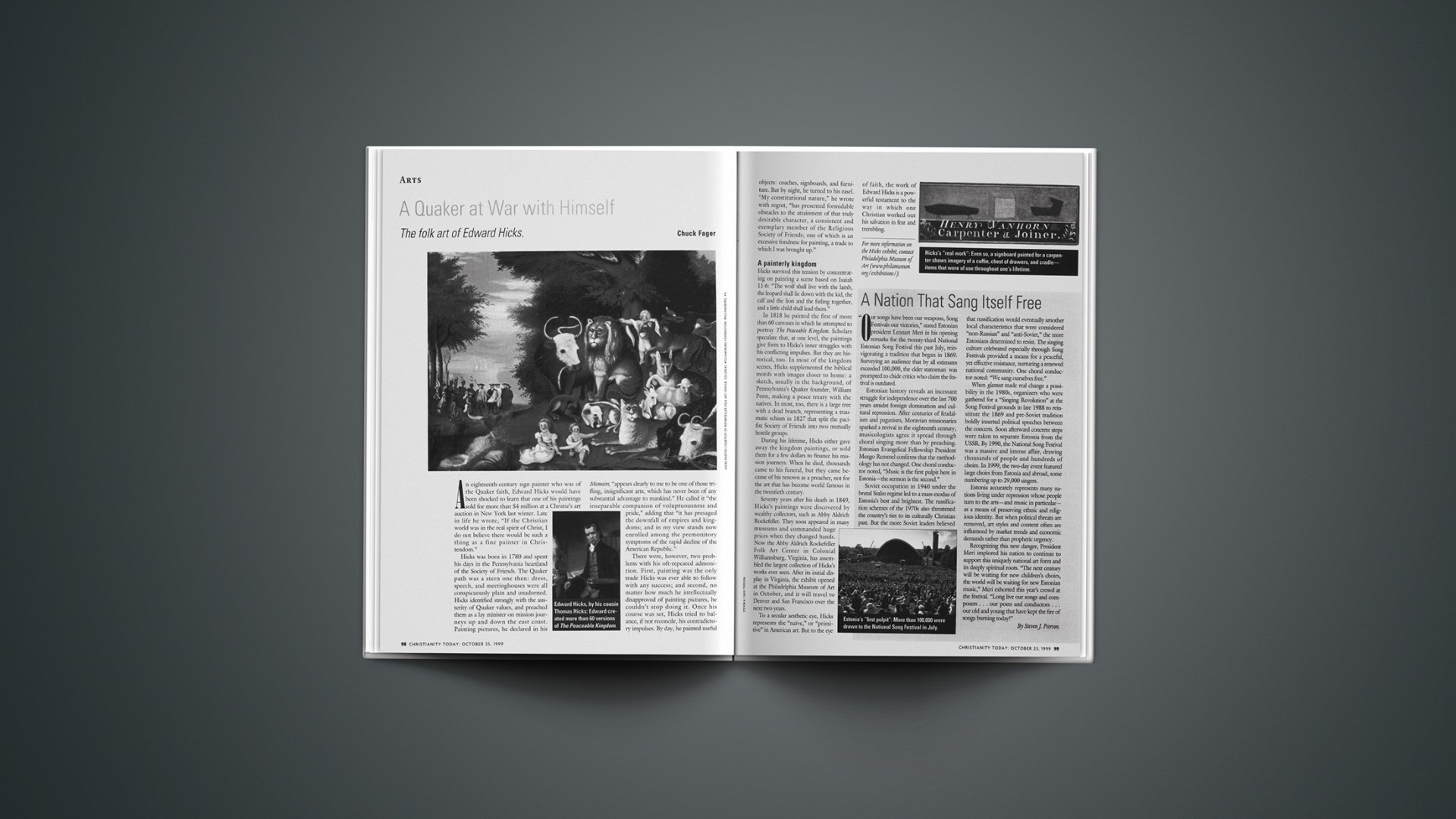An eighteenth-century sign painter who was of the Quaker faith, Edward Hicks would have been shocked to learn that one of his paintings sold for more than $4 million at a Christie’s art auction in New York last winter. Late in life he wrote, “If the Christian world was in the real spirit of Christ, I do not believe there would be such a thing as a fine painter in Christendom.”
Hicks was born in 1780 and spent his days in the Pennsylvania heartland of the Society of Friends. The Quaker path was a stern one then: dress, speech, and meetinghouses were all conspicuously plain and unadorned. Hicks identified strongly with the austerity of Quaker values, and preached them as a lay minister on mission journeys up and down the east coast. Painting pictures, he declared in his Memoirs, “appears clearly to me to be one of those trifling, insignificant arts, which has never been of any substantial advantage to mankind.” He called it “the inseparable companion of voluptuousness and pride,” adding that “it has presaged the downfall of empires and kingdoms; and in my view stands now en rolled among the premonitory symptoms of the rapid decline of the American Republic.”
There were, however, two problems with his oft-repeated admonition. First, painting was the only trade Hicks was ever able to follow with any success; and second, no matter how much he intellectually disapproved of painting pictures, he couldn’t stop doing it. Once his course was set, Hicks tried to balance, if not reconcile, his contradictory impulses. By day, he painted useful objects: coaches, signboards, and furniture. But by night, he turned to his easel. “My constitutional nature,” he wrote with regret, “has presented formidable obstacles to the attainment of that truly desirable character, a consistent and exemplary member of the Religious Society of Friends; one of which is an excessive fondness for painting, a trade to which I was brought up.”
A painterly kingdom Hicks survived this tension by concentrating on painting a scene based on Isaiah 11:6: “The wolf shall live with the lamb, the leopard shall lie down with the kid, the calf and the lion and the fatling together, and a little child shall lead them.”
In 1818 he painted the first of more than 60 canvases in which he attempted to portray The Peaceable Kingdom. Scholars speculate that, at one level, the paintings give form to Hicks’s inner struggles with his conflicting impulses. But they are historical, too. In most of the kingdom scenes, Hicks supplemented the biblical motifs with images closer to home: a sketch, usually in the background, of Pennsylvania’s Quaker founder, William Penn, making a peace treaty with the natives. In most, too, there is a large tree with a dead branch, representing a traumatic schism in 1827 that split the pacifist Society of Friends into two mutually hostile groups.
During his lifetime, Hicks either gave away the kingdom paintings, or sold them for a few dollars to finance his mission journeys. When he died, thousands came to his funeral, but they came be cause of his renown as a preacher, not for the art that has become world famous in the twentieth century.
Seventy years after his death in 1849, Hicks’s paintings were discovered by wealthy collectors, such as Abby Aldrich Rockefeller. They soon appeared in many museums and commanded huge prices when they changed hands. Now the Abby Aldrich Rockefeller Folk Art Center in Colonial Williams burg, Virginia, has assembled the largest collection of Hicks’s works ever seen. After its initial display in Virginia, the exhibit opened at the Philadelphia Museum of Art in October, and it will travel to Denver and San Francisco over the next two years.
To a secular aesthetic eye, Hicks represents the “naive,” or “primitive” in American art. But to the eye of faith, the work of Edward Hicks is a powerful testament to the way in which one Christian worked out his salvation in fear and trembling.
For more information on the Hicks exhibit, contact Philadelphia Museum of Art (www.philamuseum.org/exhibitions/).
Copyright © 1999 Christianity Today. Click for reprint information.










